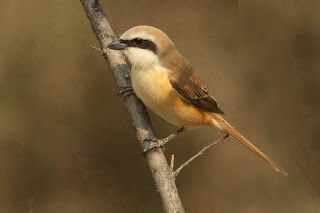Your guess is as good as mine!
Our accommodation was, to say the least, spacious. Externally, the building brought to mind the Bates Motel of Hitchcock’s Psycho movie but it was obviously no more than a year or two old. It was huge; it had meetings rooms and large communal areas but only four bedrooms.
Happy Island guesthouse
Happy Island has a history of spectacular falls of passerine migrants and after the disappointment of Beidaihe we were very much looking forward to some better birding action. We had also been led to expect good numbers of waders.
There were several birders already there who were happy to share information about the island’s best sites and what birds had been seen recently. One of them was Ray Barnes from Birmingham with whom I soon found I shared several mutual acquaintances from Bittell Reservoir and Upton Warren back in the 1970s. Who would have thought 40 years ago that our then friend, schoolboy birder Mark Brazil, would go on to author The Field Guide to The Birds of East Asia that we were all now using.
Our first day on the island was disappointing. Waders were comparatively few although they did include Far Eastern Curlew, Lesser Sand Plover, Great Knot and Terek Sandpiper so not too many complaints! Passerines of note were Daurian Starling, Japanese Grosbeak and Yellow-rumped Flycatcher but it was hard work.
Japanese Grosbeak
Our second morning was much better. Two Common Cuckoos were seen flying in off the sea at about 5.30am, there were several Siberian Stonechats where none had been before and surely that must be a different Yellow-rumped Flycatcher from the one seen yesterday! During the next few hours Grey-streaked Flycatcher, Asian Brown Flycatcher, Black-browed Reed Warbler, Radde’s, Pallas’s, Dusky & Yellow-browed Warblers, White’s Thrush, Rufous-bellied Woodpecker, Japanese Waxwing, Siberian Rubythroat and Siberian Blue Robin all contributed to making this the best day of the trip so far for migrants.
Siberian Stonechat
Grey-streaked Flycatcher
Asian Brown Flycatcher
The following day saw a similar pattern. A particular highlight was seeing Siberian Rubythroat, Siberian Blue Robin and Siberian Thrush one after the other coming to drink and bathe at the same water. Other birds during the morning were White’s Thrushes, Eye-browed Thrushes, Swinhoe’s Robin, Pale-legged Leaf Warbler, Brown Hawk Owl, Dollarbird, Taiga Flycatcher and Asian Brown Flycatcher. All of yesterday’s Grey-streaked Flycatchers had gone overnight; there wasn’t one to be found.
Eye-browed Thrush
I’m a firm believer in ‘birds first, food second’ so today I skipped both breakfast and lunch. This enabled me to walk to the far end of the island where several Saunders’s Gulls were nice to see and I agonised for a while over the identification of a probable Blyth’s Pipit among a small group of ‘yellow wagtails’. Brown Shrikes were everywhere today, several hundred of them, I would guess. I also found a Bar-tailed Godwit with a leg flag that identified it as a bird from Australia. The afternoon produced little in the way of new birds but a roosting Grey Nightjar was a highlight.
Saunders's Gull
Brown Shrike
As it was going to be my first proper meal of the day I was looking forward to dinner but it proved to be no better than the previous night, which is to say, pretty poor. There was definitely a marked contrast between the food on Happy Island and that at the hotel in Beidaihe. Dinners at the Jinshan had been generally very good although fried eggs and cold chips isn’t everyone’s idea of a hearty breakfast.
There don’t appear to be any maps of Happy Island. We were told that change there is so rapid that there would be no point! However, as long as the small woodland areas survive they will surely continue to attract migrants and I would certainly consider going back for another try.
Boardwalk through the Temple wood, probably the best site on the island
When it came time to leave the island we packed our bags a bit more carefully remembering the earlier ferry boat trip. But then there was the complete surprise when our regular minibus arrived to collect us and take us back to the mainland via the causeway. Go figure!
Back in Beidaihe, there was a single Relict Gull on the beach but our last morning there produced few other ‘new’ birds. It would actually have been awful if we had had to leave on a morning when there had been a fall.
It has to be said that this trip was only a very limited success. The positives were more than 70 lifers that included Ibisbill and quite a few ‘Sibes’ but the scale of the migration at Beidaihe and Happy Island was poor compared with accounts I have read of previous years , the numbers of waders were disappointing and the opportunities for photography were not as good as I had hoped. But I’m still glad I went!
Thanks are due to Ray Tipper who organised the trip from this end; Jean Wang of the Beidaihe Jinshan International Travel Service who made all the arrangements in China and obtained all the required permissions, all of which were impossible to fault; our Chinese guide, the delightful Carol, who seemed able to fix almost anything; our driver, who hadn’t previously adopted a western name but is now known as Ayrton - he was excellent; Mark Andrews, Paul Holt, Vaughan Ashby and everyone else who shared bird information.















No comments:
Post a Comment